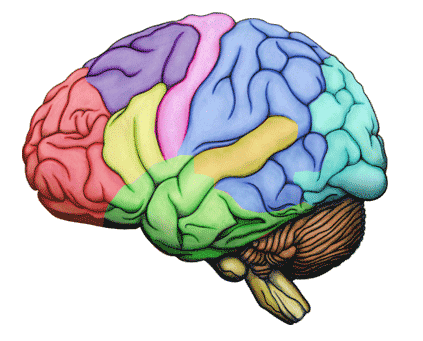
COGNITIVE NEUROSCIENCE

Brain Development
Prenatal Brain Development
Tip: Click on the box to enlarge the screen or go to the Video Files Section
Phases of Brain Development

BRAIN VIDEOS
Most brain cells are produced between the fourth and seventh month of gestation. At its peak the embryo is generating 250,000 brain cells a minute or 15 million cells per hour. Pregnant women who talk or sing to their unborn babies help to establish neural connections in the babies (Schunk, 2012, p. 51). At birth the brain has over a trillion connections – about 60 percent of the peak number of synapses that will develop over a lifetime (Jensen, 2005, p. 21). Poor nutrition, drugs, alcohol, cigarettes, and excess stress can harm the developing brain. For more on prenatal development click here:
Conception to Birth
By the age of 2, a child will have as many synapses as an adult. This is a critical period for emotions, sensory motor development, auditory development, and vision.
EMOTIONS: Healthy emotional attachment to a caregiver in the first two years helps the child develop social and emotional skills for life. Troubled early relationships negatively affect the developing brain.
SENSORY MOTOR DEVELOPMENT: Because “sensory experiences (seeing and hearing, for example) and motor experiences (movement) are so closely intertwined in the brain, scientists commonly use the term ‘sensory motor systems’ to describe how the brain processes and controls these activities” (Jensen, 2005, p. 23). During the first 24 months of life, the sensory motor systems develop through exploratory activity. The vestibular is the system in the inner ear that controls the sense of movement and balance; it greatly influences other sensory systems, and scientists link the lack of vestibular stimulation with many learning problems (Jensen, 2005, p. 23).
AUDITORY DEVELOPMENT: The child’s first two years are critical for auditory development, and this overlaps with the critical period for language development. Problems in auditory development can lead to problems in language acquisition because much language depends on hearing the speech of others (Schunk, 2012, p. 54).
VISION: Vision develops mainly during the first year. Proper visual development requires a variety of stimulating inputs from 3-dimensional objects and limited exposure to tv, DVDs, etc.
Birth to Age 2
Brains continue to need stimulation after the age of 2 years. The brain “continually is adding, deleting, and reorganizing synaptic connections and changing structurally” (Schunk, 2012, p. 52).
A critical period in language development is between birth and age 5, as it is during this time that children’s brains develop most of their language (Schunk, 2012, p. 55). A language-rich environment enhances the formation of synaptic connections and networks.
Birth to Age 2
Elementary Years
Children experience two growth spurts during this time: around 6 or 7 and around 11 or 12. Both appear to support “emerging cognitive capacities, including the ability to reason, to understand cause and effect and to grasp abstractions –concepts like honesty, liberty, or hope” (Jensen, 2005). Studies have shown that poor nutrition can impair cognition.
Teenage Years
Major changes occur during the teen years when the brain undergoes rapid and massive structural change. The “last parts of the brain to fully develop during the teen years are the frontal lobes – the centres of emotional stability as well as executive function, concentration, value and moral judgment, planning and consequence prediction” (Willis, 2007, p. 76).
The frontal cortex is responsible for:
-
Helping a person to think clearly
-
Organizing
-
Decision-making
-
Memorizing
-
Controlling impulses
-
Controlling emotions
-
Judgment
There are also “changes in neurotransmitters—especially dopamine-that can leave the brain more sensitive to the pleasurable effects of drugs and alcohol” (Schunk, 2012, p. 52) and less sensitive to the adverse effects. Studies also show that teens respond strongly to rewards.
Why do teenagers seem so much more impulsive, so much less self-aware than grown-ups? Cognitive neuroscientist Sarah-Jayne Blakemore compares the prefrontal cortex in adolescents to that of adults, to show us how typically “teenage” behavior is caused by the growing and developing brain. Source: TED
Sarah-Jayne Blakemore is a Royal Society research fellow and professor in cognitive neuroscience at University College London, where she leads the developmental group at the Institute of Cognitive Neuroscience.
-
Be succinct. Give simple and straightforward directions. Teens’ frontal lobes may not be good at storing many ideas at a time. Avoid being sarcastic and patronizing.
-
Use models. Present information in multiple modes – visual, auditory, and tactile.
-
Be a coach. Help students to develop competence and critical thinking. Use discussion, not lecture.
-
Incorporate critical thinking and decision making into activities. Discuss consequences for actions. As Schunk states, “The rapid development occurring in teens’ brains means that their decision making often is flawed. They may base decisions on incomplete information. . .” (p. 53).
-
Be understanding, rather than judgmental.
Some Practical Advice for Parents and Teachers of Teens

-
Love, Love, Love.
-
Bonding and attachment
-
Talking
-
Healthy Stimulation
-
Exploratory Games
-
Limited Exposure to television, DVDs, Internet, Movies, etc.
-
Good Nutrition
